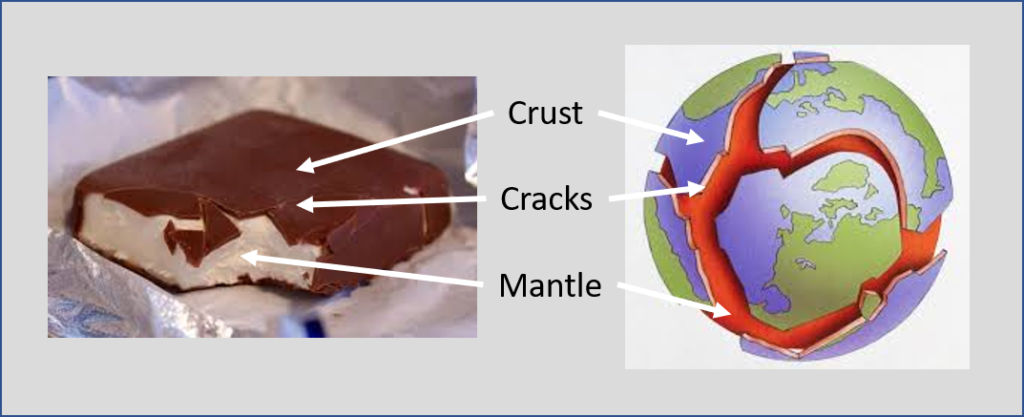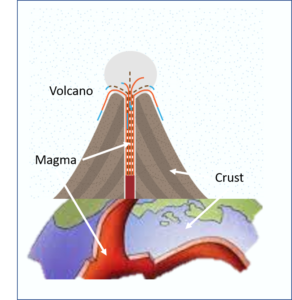The Earth’s Layers
The earth is like a chocolate covered ice cream bar. When you take that first bite – the chocolate coating cracks in a bunch of places. The chocolate coating is the Earth’s Crust and then ice cream is the Earth’s Mantle.

How do Volcanoes Erupt?
The crust of the Earth is made of tectonic plates. These plates float around on a layer of rock called the Mantle. An eruption is when pools of hot rock in the Mantle, called magma, come through the crust (sometimes bringing with it steam, ash, and rocks).
How easily the magma can escape through the volcano determines how explosive it is. If the magma can slide right out, it is a mild eruption. If it has to work really hard, it is a violent eruption. Think of a water hose. If it is free and clear, the water comes out easily. If you put a knot in the hose, the pressure builds up, and when the knot is released the water spurts out.
The Volcanic Explosivity Index (VEI) measures the scale of an eruption, it is like the Richter Scale for earthquakes in that it is logarithmic. Each number on the scale is 10 times more powerful than the last.
Scientists classify eruptions by what material comes through the volcano, how fast it is moving, and how high the eruption cloud goes. The picture shows seven common types. The volcanoes on the left are from mild explosions and the explosivity goes up as the image moves to the right.

Attribution: “Chiara Cingottini, Density Design Research Lab”. Released under CC-BY-SA license.
What is a Volcano?

Any channel through the crust that allows the magma to flow is called a volcano. A volcano has a chamber of hot magma on one end and an opening to the air (or ocean) on the other.
Volcanoes form in two places
- Via the cracks between the plates – this is most volcanos.
- Via a “hot spot” – in this spot the magma is unusually hot and breaks through the crust without the help of a crack.
75% of the world’s volcanos are on the “Ring of Fire” – a ring around the Pacific Ocean at the junction of several tectonic plates.
The Hawaiian Islands are a “hot spot” volcano that show plate tectonics in action. The hot spot remains in the same place, but the earth’s crust is moving overtop of it. As the crust moves, the volcanic shield mountains drift away and new mountains form. The largest Island, Hawai`i, is the newest, and it still being built. 18 miles off the southeast coast the volcano Lo`ihi is being formed under the water. In approximately 50,000 years it will break the surface, forming its own island or joining Hawai`i. All told, the Hawaiian-Emperor seamount chain stretches about 3,900 miles and consists of at least 80 volcanoes. A majority of them have eroded back into the sea as they move away from the hot spot.
These eruptions change the surface of the earth. When the lava, ash, and mud settle on the earth’s crust, they build up mountains layer by layer. Imagine dumping sand from a bucket onto the ground – as the sand hits the ground it builds up into a mound.
Volcano Types
- Composite or Strato – formed from violent eruptions of magma, steam, ash, rock, and dust. As the eruption debris settle, it builds up a steep sided mountain. Mount St Helens is an example.
- Caldera – formed when a large eruption wakens the base of the volcano, and it collapses it on itself. A Caldera looks like a large hole or crater in the land.
The 1815 eruption of Mt Tambora in Indonesia reduced the volcano from a 14,100 ft high Composite to a 9.350 ft high Caldera.
- Shield – formed when fast-moving lava oozes out of cracks or hot spots. Over time this flow builds up into a gradually sloping mountain. The name “shield” comes from the fact that these mountains look like a soldier’s shield lying on the ground. The Hawaiian Islands are an example.
- Dome – like “shield” volcanos, except the lava oozes out really slowly. The mountain is steep sloped, because the lava does not travel as far before cooling.
Lava and Magma? What’s the difference?
Magma is molten rock beneath the surface, while lava is molten rock once it escapes the volcano.
Further Information
Cool Videos
Everything you need to know about Planet Earth
Volcanoes from Nat Geo Kids
Nat Geo Volcanoes
Further Reading
https://www.nationalgeographic.org/article/plate-tectonics-ring-fire/
https://www.hawaii guide.com/content/posts/hawaii_geology_and_geography
http://www.geography.learnontheinternet.co.uk/topics/typesvolcanoes.html
https://en.wikipedia.org/wiki/Types_of_volcanic_eruptions
https://en.wikipedia.org/wiki/Mount_Tambora
https://en.wikipedia.org/wiki/Hawaiian%E2%80%93Emperor_seamount_chain
